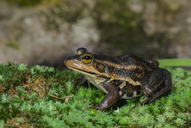|
Rana virgatipes Cope, 1891
Carpenter Frog Subgenus: Aquarana | family: Ranidae genus: Rana |
|
Taxonomic Notes: This species was placed in the genus Lithobates by Frost et al. (2006). However, Yuan et al. (2016, Systematic Biology, doi: 10.1093/sysbio/syw055) showed that this action created problems of paraphyly in other genera. Yuan et al. (2016) recognized subgenera within Rana for the major traditional species groups, with Lithobates used as the subgenus for the Rana palmipes group. AmphibiaWeb recommends the optional use of these subgenera to refer to these major species groups, with names written as Rana (Aquarana) catesbeiana, for example. |
|
 © 2013 Don Filipiak (1 of 12) |
|
|
|
Description Distribution and Habitat Country distribution from AmphibiaWeb's database: United States U.S. state distribution from AmphibiaWeb's database: Delaware, Florida, Georgia, Maryland, North Carolina, New Jersey, Virginia
Adults live in sphagnum bog pools, small ponds, and the borders of quite streams. In New Jersey it is confined to such habitat in the pine barrens. Adults are found on the water's edge and more commonly seen resting on partially submerged logs or among vegetation. Life History, Abundance, Activity, and Special Behaviors
References
Gosner, K. L. and Black, I. H. (1963). ''Rana virgatipes (Cope). Carpenter Frog.'' Catalogue of American Amphibians and Reptiles. American Society of Ichthyologists and Herpetologists, 67.1-67.2. Originally submitted by: Franziska Sandmeier (first posted 2001-02-23) Species Account Citation: AmphibiaWeb 2001 Rana virgatipes: Carpenter Frog <https://amphibiaweb.org/species/5181> University of California, Berkeley, CA, USA. Accessed Nov 21, 2024.
Feedback or comments about this page.
Citation: AmphibiaWeb. 2024. <https://amphibiaweb.org> University of California, Berkeley, CA, USA. Accessed 21 Nov 2024. AmphibiaWeb's policy on data use. |




 Map of Life
Map of Life